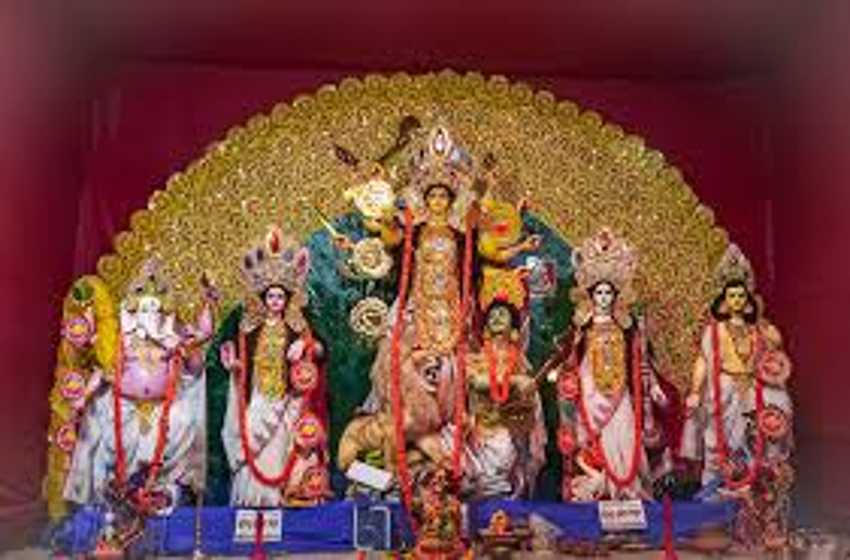Smiling blue skies trimmed with fleecy white clouds, gentle breeze, warm sunshine, and the ‘cash’ flowers usher in the month of Aswin (September – October). It is the time for Durga Puja, the main festival of West Bengal, bringing with it new hope to the hearts of all Bengalis.
Celebration of Durga Puja
Durga puja or Durgotsava starts off a chain of festivals that end with Saraswati Puja. Mahalaya and the pre-dawn recitation from the Chandi announce the advent of Durgotsava. Preparations and expectations culminate in the Puja days, Shashti, Saptami, Ashtami, and Navami. The beat of drums, the clash of cymbals, the ringing of bells, dances before the image of Durga, and incense wafting in the air, all form an integral part of Durga puja. All too soon it is Bijoyam the day when the images are taken in a procession and immersed in the river. Bengalis go back to their mundane lives to wait another year to welcome the goddess.
Significance of Durga Puja
Durga Puja, as we know it today, is a festival, that binds together people from all walks of life, irrespective of caste, creed, and religion. It is a community festival, though in some houses they still have private pujas. Durgotsava has turned out to be a source of livelihood for people in different spheres. The image-maker, the priest, the florists, the dhaki (drum-beater), grocers, confectioners, and volunteers are all part and parcel of this festival. It is a time to exchange gifts. This is the season for new clothes. The puja generates enthusiasm as well as income for countless people.
A notable feature of Durga Puja in West Bengal is the Puja issue of a magazine. This cultural aspect is a literary offering on the eve of Mahalaya Amavasya. This unique feature of Bengal reminds us that it has always been at the forefront of culture. Associated with the Puja, cultural functions and melas (fairs) are held. This means creating mass contact and developing various folk arts and cottage industries.
History of Durga Puja
A peep into the past presents us with a rich background of the mythological and historical aspects of this great festival. Durga was a Puranic Goddess. In the Puranas, the struggle between the Gods and demons or ‘asuras’ is mentioned. The Gods could not subdue Mahisasura, the king of demons, who drove the gods out of heaven. They went to Vishnu who told them that it would be possible for someone other than a God to defeat Mahisasura. The name Tilottama and not Durga is found in the Puranas. She was created with all the special attributes. Shiva gave her his trident, Vishnu his die, the spear was given by Yama, Agni gave a dart, Kubera a club, Kala a sword, Surya a quiver full of arrows for a magical bow given by Vayu; Varuna provided her with a conch to announce her victory; Viswakarma a battle axe and Indra his thunderbolt. Himavan gave her a mount – a ferocious lion. She was also adorned with jewels.
She subjugated Mahisasura and is also known as Mahisasurmardini, who disappeared into nothingness. Mahisasura is identified as a block buffalo.
The war between the asuras and the Gods took place in spring, the season for the war. It is said that Ram invoked the blessings of Chandi in Autumn before attacking Lanka. This was not the proper time for war. Therefore Rama had to invoke Chandi so as to be victorious. The Chandi – worship of Rama was called “Akal Bodhan” the untimely worship.
Another myth centres around Parvati, the daughter of Menaka and Himalaya. She unwillingly married Shiva. The Durga mythology slowly crept into the social mainstream and gave rise to poignant yet common social feelings. Durga has other common household names like Uma, Gauri, Lalita, and so on.
Origin of Durga Puja in Modern Era
Durga Puja was not prevalent anywhere in Bengal before the 15th century. In the folk songs of the Bauls “wandering minstrels of North and West Bengal, the arrival of Gauri in Autumn”, has been sung.
The historical evidence of Durga Puja can be traced to the time of Hossain Shah Sultan of Bengal. It was the Golden Age of Bengal, the end of the fifteenth century. Political power was in the hands of the zamindars. The zamindars of North Bengal were all-powerful. There was a great rivalry between the zamindars of Dinajpur and Malda for social supremacy. The zamindars of Dinajpur initiated Durga Puja. Akal Bodhan, on the day when Rama worshipped Durga. He spent 9,00,000. There was great pomp and pageantry and the climate was excellent as it was autumn.
The zamindars of Malda to out-beat their rival performed Basanti Puja according to Puranic tradition in Chaitra and spent 9,50,000. The next year, both did Durga Puja in Autumn.
Later, the centre of Muslim rule shifted from Gaur to Dhaka. The zamindars flourished in East Bengal. They vied with each other and Durga Puja was performed by most. In the eighteenth century, it spread to other parts of Bengal. It is difficult to pinpoint the date but Radhakanto Deb and Kalikrishna Thakur brought the festival to Calcutta.
The Maratha or Borgis would annually invade Bengal. They adopted Durga Puja and carried it westward with them. It is performed with different names in many parts of the country, particularly in the eastern region and especially in Bengal. In Nepal, it is performed as Chandi Puja.
Durga Puja as we know it today has undergone a vast change from the past. It is performed by Bengalis all over the world. Twelve friends or Baro Yar first joined together and performed a community Durga Puja. It came to be known as Baroyari, then Barbara.
A few Durga Pujas in Calcutta are organized wholly by women, Durgotsav is now a community festival and has spread to every nook and cranny of Bengal.

